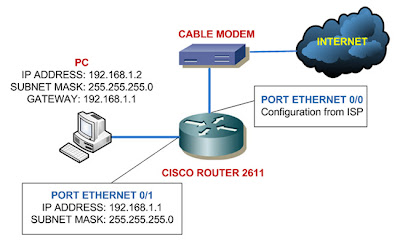If you just bought your first used Cisco router, I bet one thing you want to immediately do is connecting the Cisco router to the cable internet.
I know I did, I have cable internet for my home network. Previously I used Linksys router to get my LAN connected to the internet.
Configuring Cisco router to connect to the cable internet is easy work, even if you know only the basic configuration stuff in Cisco.
I need to warn you that this configuration will be in series or else this configuration will be a very long post. And also this series will be a good chance to learn some aspects in configuring Cisco router.
All you need to do is to set the IP address of the interfaces, set the router as a DHCP server if you want it, configure NAT, and the last thing is routing. Very simple indeed.
I'm only going to show you to get your router up and running, I wont discuss about access list and other fancy stuff - that's for the next posts.
Also the devices involve in this tutorial is only the Cisco 2611 router, Motorola cable modem, and my PC. If you want to use other Cisco devices you might need to do more configuration.
In this Part 1, I'm going to review about the concept of this configuration, please look at the topology image below: Configure IP Address of the Router's Interfaces
Configure IP Address of the Router's Interfaces
The router will get the ip configuration from DHCP server of the ISP, the Ethernet 0/0 port I use as the exit point to the internet.
The Ethernet 0/1 will be the port where my computer is connected. I'm going to set private IP address as the gateway for the computer.
Setting IP address of the interfaces is definitely a topic in the CCNA exam.
Configure the Router as DHCP Server
In this example I'm using the router as DHCP server, giving IP addresses to the computer along with other configuration such as subnet mask, gateway address, and the dns server ip address.
You won't be tested about setting router as DHCP Server in the CCNA exam, it will show up in the CCNP exam.
Configure NAT (Network Address Translation) in The Router
NAT is a powerful concept, you have one public IP address given by the ISP and also private IP addresses in your LAN.
What NAT will do is translate all your private IP address into the public IP address. If you're using overload - one public IP address used by many private IP address - the private IP address is converted into logical ports.
For example, if you got public IP address of 10.1.1.1, then the form of the translation might be like this 10.1.1.1:3000
NAT is also a topic in the CCNA exam and one of the thoughest that is.
Configure Routing
This example only shows the basic static routing, the router will send all request from the client (from port Ethernet 0/1) to the port Ethernet 0/0.
You surely want to learn about routing for the CCNA exam.
Please read also:
Configure Cisco Router to Work With Cable Internet - Part 2
Configure Cisco Router to Work With Cable Internet - Part 3
Configure Cisco Router to Work With Cable Internet - Part 4
Configure Cisco Router to Work With Cable Internet - Part 1
Posted by Internet at Every Where on 7:01 AM
 RSS Feed
RSS Feed Twitter
Twitter